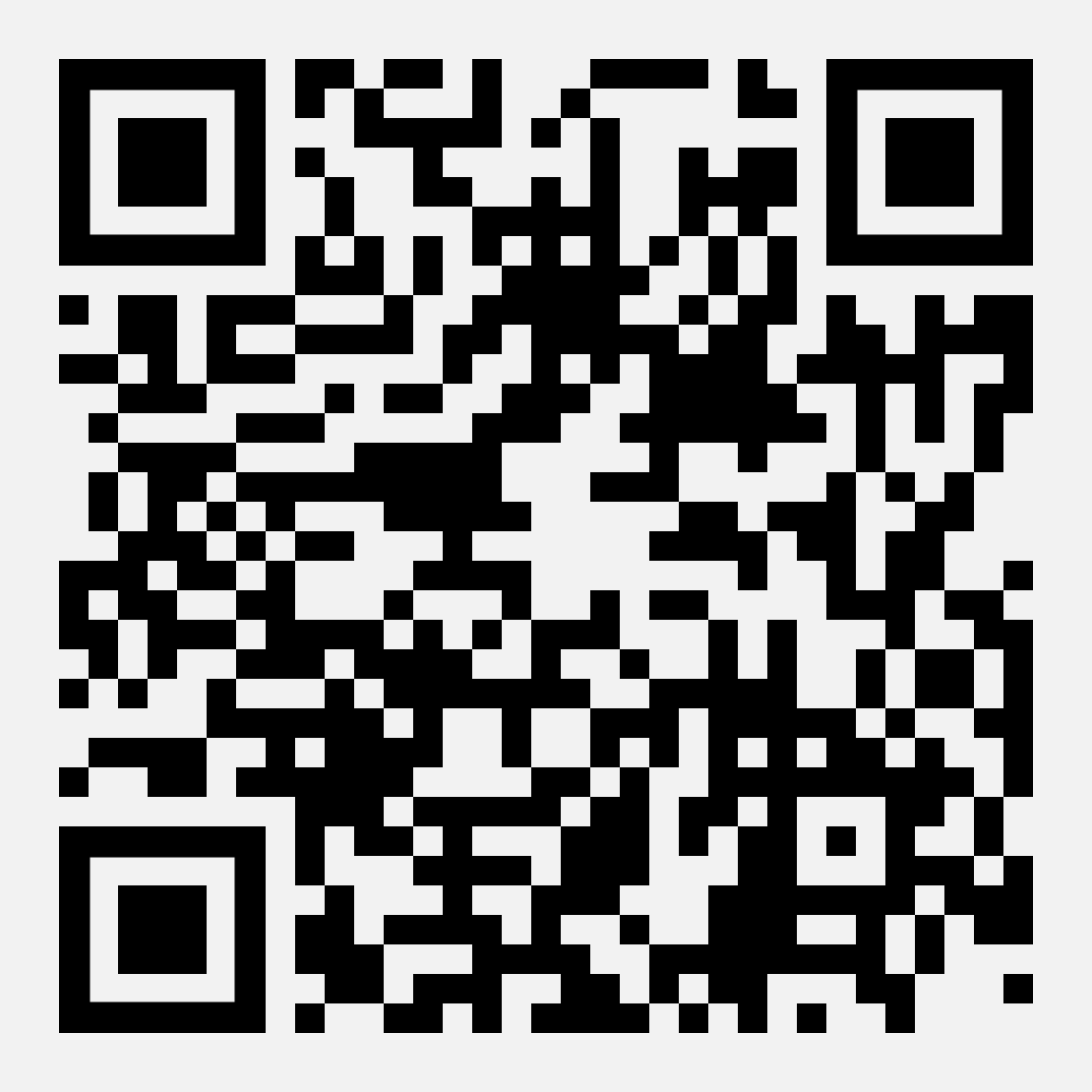Mapping the Market: Segmentation, Targeting, and Positioning
Common Segmentation Approaches
As we learned in Chapter 2, organizational markets and consumer markets differ in their characteristics, needs, and purchasing behaviours. Due to their differences, organizational and consumer markets are segmented differently.

Consumer Markets: B2C Segmentation Approaches
Some of the most common segmentation approaches used in B2C (business to consumer) markets are:
- Demographic segmentation
- Geographic segmentation
- Psychographic segmentation
- Behavioural segmentation
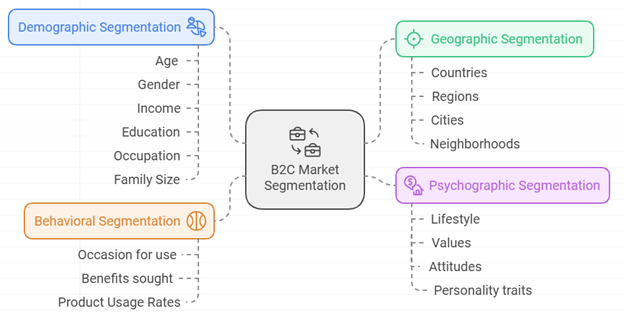
Demographic Segmentation
Demographic segmentation involves dividing the market based on demographic factors, such as age, gender, income, education, occupation, and family size. It is one of the simplest and most widely used methods because demographic data is relatively easy to obtain and analyze.
For example, a company might target young adults aged 18–24 with a new line of trendy clothing.
Geographic Segmentation
Geographic segmentation divides the market based on location, such as countries, regions, cities, or neighbourhoods. This method is particularly useful for businesses that need to cater to regional preferences or climate conditions.
For instance, a retailer might promote winter clothing in colder regions while focusing on summer apparel in warmer areas.
Psychographic Segmentation
Psychographic segmentation divides the market based on psychological characteristics, including lifestyle, values, interests, and personality traits. It provides deeper insights into consumer motivations and can be used to create highly targeted marketing campaigns.
For example, a brand might target environmentally conscious consumers with sustainable products.
Behavioural Segmentation
Behavioural segmentation focuses on consumer behaviours, such as purchasing habits, benefits sought, brand interactions, and product usage rates. This approach helps businesses target consumers based on their behaviour with the brand.
For example, a streaming service might offer personalized recommendations based on a user’s viewing history.
Examples
Leisure Profile Segments Using Different Segmentation Approaches
Demographic Factors
Age-Based Segmentation:
- Young Adults (18–30 years): This segment often seeks adventure and social experiences. Travel packages might include activities like backpacking and nightlife as well as budget accommodations such as hostels. Marketing strategies for this group emphasize excitement, exploration, and affordability.
- Seniors (60 years): Older travelers may prefer leisurely paced tours, comfortable accommodations, and cultural experiences. This segment values safety, convenience, and relaxation. Travel companies might offer guided tours, cruises, or wellness retreats tailored to seniors.
Family Status Segmentation:
- Families with Young Children: This segment looks for family-friendly destinations that offer entertainment and activities suitable for children. Resorts with kids’ clubs, theme parks, and family-oriented attractions are popular choices. Marketing messages focus on creating memorable family experiences and convenience.
- Couples Without Children: Couples may seek romantic getaways or adventure travel. Destinations that offer privacy, luxury accommodations, and activities like wine tasting or hiking appeal to this group. Marketing emphasizes romance, exclusivity, and adventure.
Income-Based Segmentation:
- High-Income Travelers: This segment often seeks luxury experiences and exclusive destinations. High-end resorts, private tours, and bespoke travel experiences cater to their preferences. Marketing strategies highlight luxury, exclusivity, and personalized service.
- Budget-Conscious Travelers: These travelers look for affordable travel options and value for money. Budget airlines, hostels, and package deals are popular among this segment. Marketing focuses on affordability, deals, and maximizing travel experiences within a budget.
Occupation-Based Segmentation:
- Corporate Travelers: Business professionals often require efficient travel solutions that offer convenience and connectivity. This segment values amenities like high-speed internet, business centres, and proximity to business districts. Marketing messages emphasize efficiency, productivity, and comfort.
Geographic Factors
Urban vs. Rural Tourists:
- Urban Tourists: Urban areas attract tourists interested in cultural experiences, shopping, nightlife, and dining. These tourists are often from rural or suburban areas seeking the excitement and diversity of city life. Marketing for urban tourism highlights cultural attractions, events, and city tours.
- Rural Tourists: Rural destinations appeal to tourists looking for peace, nature, and outdoor activities. These tourists might come from urban areas seeking a retreat from the hustle and bustle of city life. Marketing for rural tourism focuses on nature, tranquility, and local experiences.
Domestic vs. International Tourists:
- Domestic Tourists: These tourists are those traveling within their own country. They might be segmented further based on regions, such as Northeastern versus Southwestern tourists in the United States. Marketing for domestic tourism often emphasizes ease of travel and familiarity with the culture and language.
- International Tourists: These tourists are those traveling from abroad. They might be segmented based on their country of origin, such as European versus Asian tourists. Marketing for international tourism highlights unique cultural experiences, historical sites, and attractions that are distinct from the tourists’ home countries.
Climate-Based Segmentation:
- From Colder Climates: Tourists from colder climates may seek destinations with warmer weather, especially during winter months. These tourists are often drawn to tropical or subtropical regions. Marketing for these destinations focuses on sunshine, beaches, and warm-weather activities.
- From Warmer Climates: Conversely, tourists from warmer climates might seek cooler destinations, particularly during hot summer months. These tourists may be interested in destinations with mountains, forests, or cooler urban environments. Marketing for these destinations emphasizes cool weather, scenic landscapes, and outdoor activities.
Psychographic Factors
- Adventure Seekers: This segment includes tourists who are motivated by thrill and excitement. They seek out destinations and activities that offer adventure, such as rock climbing, white-water rafting, or skydiving. Marketing strategies for this group emphasize the adrenaline rush and unique experiences that these activities provide.
- Cultural Enthusiasts: Cultural enthusiasts are travelers who are interested in exploring and experiencing the cultural heritage of destinations. They value learning about different cultures, histories, and traditions. Tour operators might offer packages that include museum visits, historical site tours, and cultural festivals — appealing to tourists who value educational and immersive cultural experiences.
- Wellness Travelers: This segment focuses on tourists seeking relaxation, health, and personal well-being. They are interested in activities like yoga retreats, spa treatments, and meditation sessions. Marketing for wellness tourism emphasizes rejuvenation, stress relief, and holistic health benefits — catering to tourists looking for a restorative vacation.
- Luxury Indulgers: Luxury travelers seek high-end, exclusive experiences. This segment values premium services, privacy, and personalized attention. Marketing strategies for luxury tourism focus on luxury accommodations, fine dining, and bespoke experiences that cater to the sophisticated tastes and preferences of this segment.
- Eco-Conscious Travelers: Eco-conscious travelers prioritize sustainability and nature conservation. They are interested in experiences that allow them to connect with nature while minimizing their environmental impact. Marketing for eco-tourism highlights sustainable practices, conservation efforts, and opportunities to engage with local ecosystems and communities.
Behavioural Factors
- Frequent Travelers: This segment includes individuals who travel often, whether for business or leisure. They are typically loyal to certain brands or services and may participate in loyalty programs. Marketing strategies for this group emphasize rewards, exclusive offers, and personalized experiences to maintain their loyalty and encourage repeat bookings.
- First-Time Visitors: First-time visitors to a destination may require more information and guidance compared to repeat visitors. This segment values comprehensive travel guides, introductory tours, and easy-to-navigate services. Marketing efforts focus on providing detailed information, special welcome packages, and introductory discounts to attract these travelers.
- Last-Minute Bookers: This segment consists of travelers who make spontaneous or last-minute travel decisions. They often look for deals and flexible booking options. Marketing strategies target this group with time-sensitive promotions, last-minute deals, and flexible cancellation policies to capture their interest.
- Seasonal Travelers: Seasonal travelers plan their trips around specific times of the year, such as summer vacations or winter holidays. This segment is influenced by seasonal events and attractions. Marketing efforts focus on promoting seasonal activities, events, and special offers that align with their travel timing.
- Occasional Travelers: Occasional travelers take trips less frequently, often for special occasions or holidays. They may prioritize value for money and unique experiences. Marketing efforts for this segment focus on special promotions, package deals, and highlighting unique destination features that make the trip memorable.
A Classification Dilemma: Is “Benefits Sought” a Psychographic or Behavioural Segmentation Basis? Can It Be Both?
Psychographic segmentation focuses on why customers buy (psychological), while behavioural segmentation focuses on what, when, and how they buy (observable behaviour).
If psychographic segmentation focuses on why customers buy, while behavioural segmentation focuses on what, when, and how they buy, then why do we classify “benefits sought” segmentation as behavioural? It is not easily observable, but rather more aligned to motivation.
This observation highlights a key conceptual tension in marketing theory: an inconsistency in how benefits sought segmentation is traditionally classified.
Benefits sought is primarily considered a behavioural segmentation basis, as it focuses on what consumers want to get from a product or service rather than their personality traits or lifestyle characteristics. However, there is some overlap with psychographic segmentation since benefits sought often stem from psychological motivations and lifestyle preferences.
The Classification Dilemma
Benefits sought segmentation does share more characteristics with psychographic segmentation because it:
- Focuses on underlying motivations and reasons for purchase
- Requires understanding customer needs and wants
- Is not directly observable from behavioural data
- Often requires primary research like surveys and interviews
- Answers the “why” of customer purchase decisions
Historical Context
The classification of benefits sought under behavioural segmentation likely emerged because:
- Early marketing theorists grouped it with usage-based segmentation.
- Benefits can be linked to specific product features and attributes.
- Purchase behaviour often directly reflects desired benefits.
- It is more actionable than pure psychographic variables.
Modern Perspective
Contemporary marketing scholars increasingly recognize benefits sought as a hybrid form of segmentation that bridges:
- Psychographic elements (motivations, desires, and needs)
- Behavioural elements (feature preferences and usage patterns)
Practical Implications
This understanding suggests that benefits sought segmentation should be approached by integrating both observable behaviours and underlying motivations.
Tourism and Hospitality Example
A resort hotel guest seeking “relaxation” as a benefit might choose this because of:
- Behavioural Factors:
- Purpose of stay (vacation versus business)
- Usage rate (frequent versus occasional traveler)
- Specific amenities used (spa services and quiet zones)
- Related Psychographic Elements:
- Motivation, desire, and need for relaxation
- Lifestyle (wellness-oriented)
- Values (work-life balance)
- Attitudes toward leisure
This dual nature makes benefits segmentation particularly valuable for service marketing, as it bridges both behavioural actions and psychological motivations.
Leisure Profile Segments Using Combined Approaches
Market segment profiles are increasingly created using a combination of segmentation bases to define distinct groups of consumers. These profiles help businesses tailor their marketing strategies to better meet the needs and preferences of each segment. Below are some examples of market segment profiles using combined approaches.
Examples
Leisure Profile Segments Using Combined Approaches
Urban Millennials
Demographic: Aged 25–35; single or newly married; college educated.
Geographic: Reside in urban areas with access to public transportation and cultural amenities.
Psychographic: Value experiences over possessions; environmentally conscious; tech-savvy.
Behavioural: Frequent users of mobile apps for travel and dining; prefer experiences like concerts and local events.
Profile Summary: This segment is targeted with marketing strategies that emphasize convenience, sustainability, and unique urban experiences. Promotions might include discounts on public transportation passes or exclusive access to local events.

Suburban Family Vacationers
Demographic: Families with children aged 5–15; parents aged 35–45.
Geographic: Live in suburban areas with a preference for family-friendly environments.
Psychographic: Value family time and educational experiences for their children.
Behavioural: Plan vacations around school holidays; prefer destinations with activities for all ages.
Profile Summary: Marketing efforts focus on family packages that include attractions like theme parks and educational tours. Offers might include group discounts and child-friendly amenities.

Luxury Business Travelers
Demographic: Aged 45–60; high-income professionals, often in executive roles.
Geographic: Based in major business hubs; frequently travel internationally.
Psychographic: Value efficiency, comfort, and exclusivity.
Behavioural: Regularly book premium flights and accommodations; loyal to specific hotel chains.
Profile Summary: This segment is targeted with marketing that highlights luxury and convenience, such as expedited check-in services and exclusive lounge access. Loyalty programs and personalized services are key selling points.

Eco-Conscious Retirees
Demographic: Aged 60–75; retired; moderate to high income.
Geographic: Reside in environmentally progressive regions.
Psychographic: Strong interest in sustainability and conservation; prefer slow-paced travel.
Behavioural: Choose destinations known for eco-friendly practices; participate in conservation activities.
Profile Summary: Marketing strategies emphasize sustainable travel options, such as eco-lodges and volunteer tourism opportunities. Promotions might include discounts for extended stays and partnerships with conservation organizations.

Adventure-Seeking Young Adults
Demographic: Aged 18–30; single or in relationships; diverse educational backgrounds.
Geographic: From both urban and rural areas; willing to travel internationally.
Psychographic: Thrill-seekers; value unique and challenging experiences.
Behavioural: Spontaneous travel planners; interested in activities like hiking, surfing, and extreme sports.
Profile Summary: Targeted with marketing that highlights adventure packages and off-the-beaten-path destinations. Offers might include flexible booking options and group discounts for adventure tours.
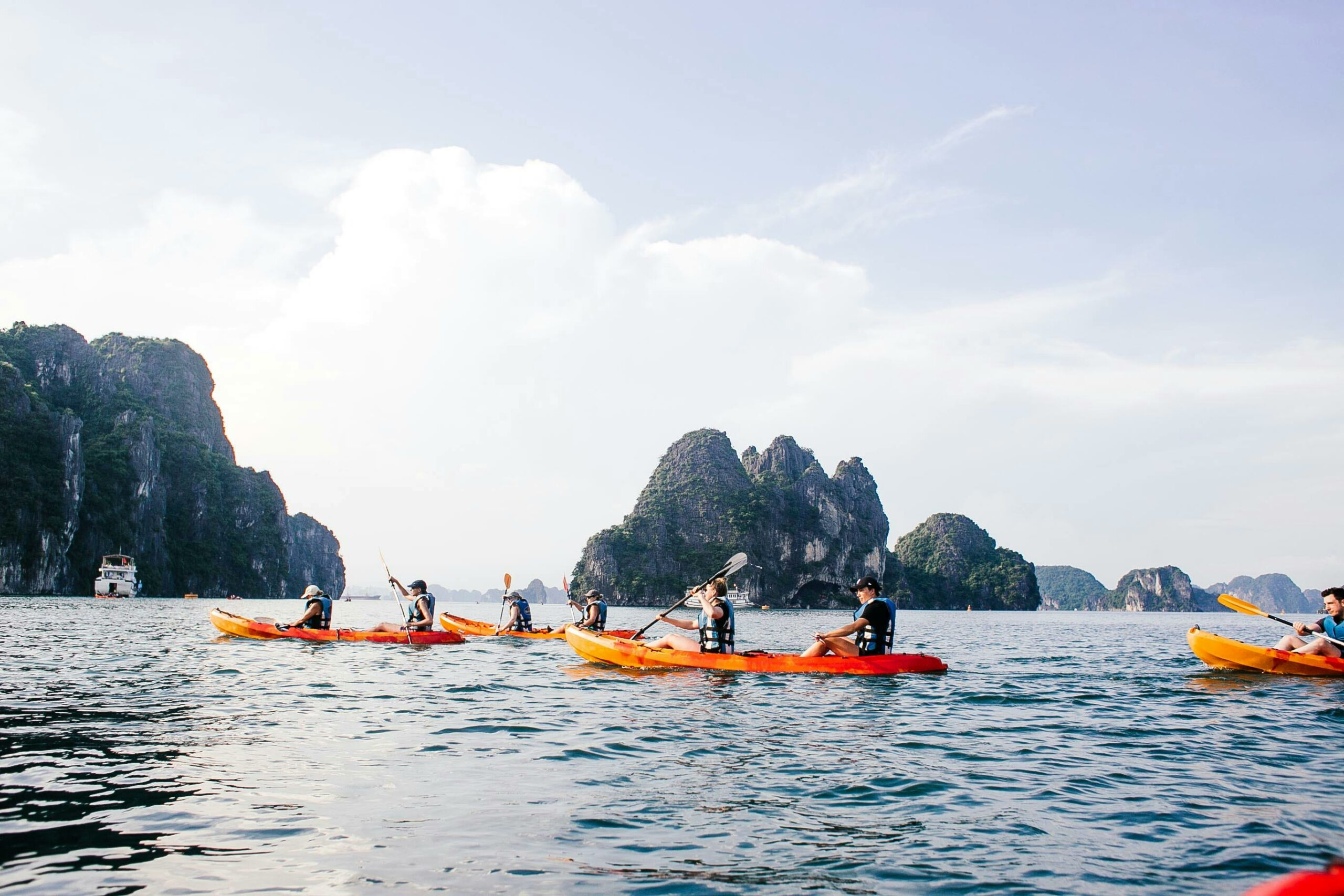
Because effective segmentation is complex and requires resources and research skills, many commercial tools and models have emerged to serve the needs of organizations.
Example
Environics Analytics
Environics Analytics is a provider of market segmentation services, offering tools and systems that help businesses understand and engage with their customers more effectively. One of their key offerings is the PRIZM segmentation system, which is widely used in Canada to classify neighbourhoods into distinct lifestyle segments.
PRIZM is a consumer segmentation system that classifies Canadian neighborhoods into 67 unique lifestyle types. It integrates geographic, demographic, and psychographic data to provide a detailed picture of consumer behaviour and preferences.
The system is designed to help businesses understand where their customers live, what they do, and what they value — enabling more effective marketing strategies and decision-making.
Learn more about the PRIZM segmentation system on the Environics Analytics website[1].
Buyer Personas
Taking market segment profiles one step further, a common practice in marketing is to develop a “buyer persona” to represent the profile of a semi-fictional person to represent this segment.
The buyer persona is like the avatar of the ideal customer 😊

Market segmentation and buyer personas complement each other: market segmentation provides the broad categorization of the audience, while buyer personas offer a deeper, more nuanced understanding of individual customer types within those segments.
Example
Relationship Between Market Segmentation and Buyer Personas
| Market Segmentation | Buyer Personas |
|---|---|
| Market Segmentation involves dividing a broader market into smaller, more manageable groups based on shared characteristics, such as demographics, geography, behaviour, and psychographics. This process helps businesses identify and target specific segments with tailored marketing strategies, allowing for more efficient and effective communication with potential customers. | Buyer Personas, on the other hand, are detailed, semi-fictional representations of individual customers within these segments. They are created using data and research to embody the specific traits, behaviours, needs, and goals of ideal customers. Personas help marketers craft personalized content and messaging that resonates with individual customer archetypes, making them useful for tactical daily operations.
“How to Create a Buyer Persona” [5:52 min] by HubSpot Marketing[2] We will learn more about the marketing research needed to create buyer personas in Chapter 4. If you are using a printed copy, you can scan the QR code with your digital device to go directly to the video: How To Create a Buyer Persona (FREE Template)
|
| Example: Hotel Market Segmentation
A luxury hotel chain might segment its market as follows:
This segmentation provides a broad overview of the hotel’s main customer groups, allowing for initial targeting and resource allocation. |
Example: Buyer Persona for the “Business Traveler” Segment
Name: Executive Emma Age: 35–45 Occupation: Senior manager in a multinational corporation Income: $150,000 Marital Status: Married with one child Travel Frequency: 2–3 times per month Preferences:
Pain Points:
Goals:
|
| Example: Leisure/Recreation Segmentation
A water park might segment its visitors by age and family structure:
This segmentation helps the water park design offerings for each group. However, it does not provide insight into why these groups might choose their park or what specific challenges they face. |
Example: Buyer Persona for the “Families” Segment
Buyer personas add depth to segmentation by creating detailed profiles of individual customers within those groups. Let’s create a persona for one of the water park’s key segments: Meet Family Planner Fiona:
With this persona, the water park can go beyond generic family discounts and create tailored marketing campaigns — like promoting “Family Fun Days” with discounted tickets, meal combos, and activities designed for parents who want to relax while their kids play. |
The Evolution of Market Segmentation in Tourism
The evolution of market segmentation in tourism has been significantly influenced by Stanley Plog’s psychographic model and has continued to develop with advancements in data analytics and marketing strategies.
Stanley Plog’s Model
Stanley Plog introduced his psychographic model in 1974[3], which categorized tourists based on their personality traits and travel preferences. Although the model has been criticized, it is considered a seminal work in tourism research and theory. This model has had a significant impact on the field of tourism studies and continues to be widely referenced and discussed[4][5].
Plog’s model identified three primary types of tourists along a contiuum: at one end allocentrics (or venturers), who seek novel and adventurous experiences, followed by mid-centrics, then at the other end, psychocentrics (or dependables), who prefer familiar and comfortable destinations.
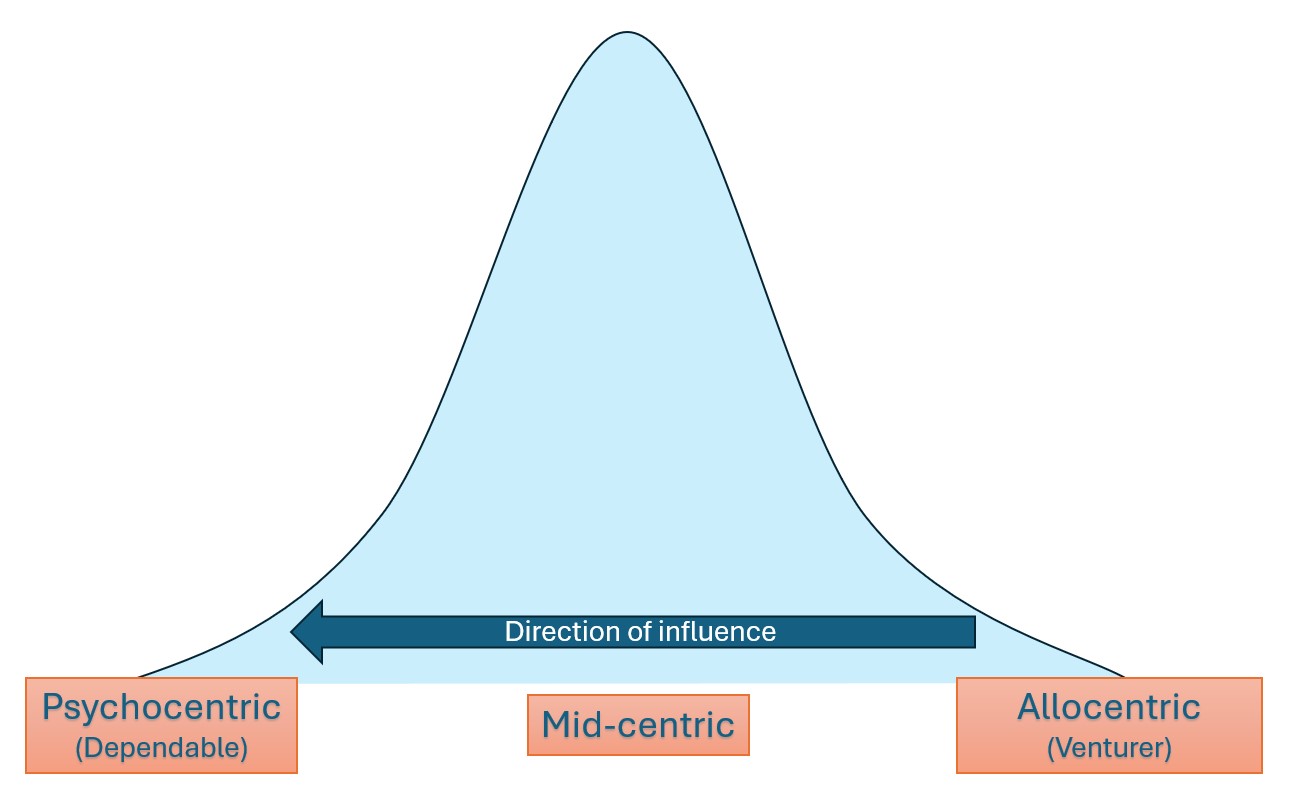
“Plog’s Model Of Allocentricity And Pschocentricity Made SIMPLE” [12:59 min] by Dr Hayley Stainton[6]
If you are using a printed copy, you can scan the QR code with your digital device to go directly to the video: Plog’s Model Of Allocentricity And Pschocentricity Made SIMPLE

Advancements in Market Segmentation
Since Plog’s model, market segmentation in tourism has evolved to incorporate a broader range of factors, including demographic, geographic, behavioural, and psychographic characteristics.
Destination marketing organizations (DMOs) have played an important role in the evolution of market segmentation for tourism. DMOs are organizations responsible for promoting and marketing a specific destination — such as a city, region, or country — to potential visitors. This involves identifying and targeting specific market segments, which allows them to effectively promote destinations and tailor messages to resonate with different audience groups. Segmentation practices used by DMOs have been shaped by advances in technology and market research methods.
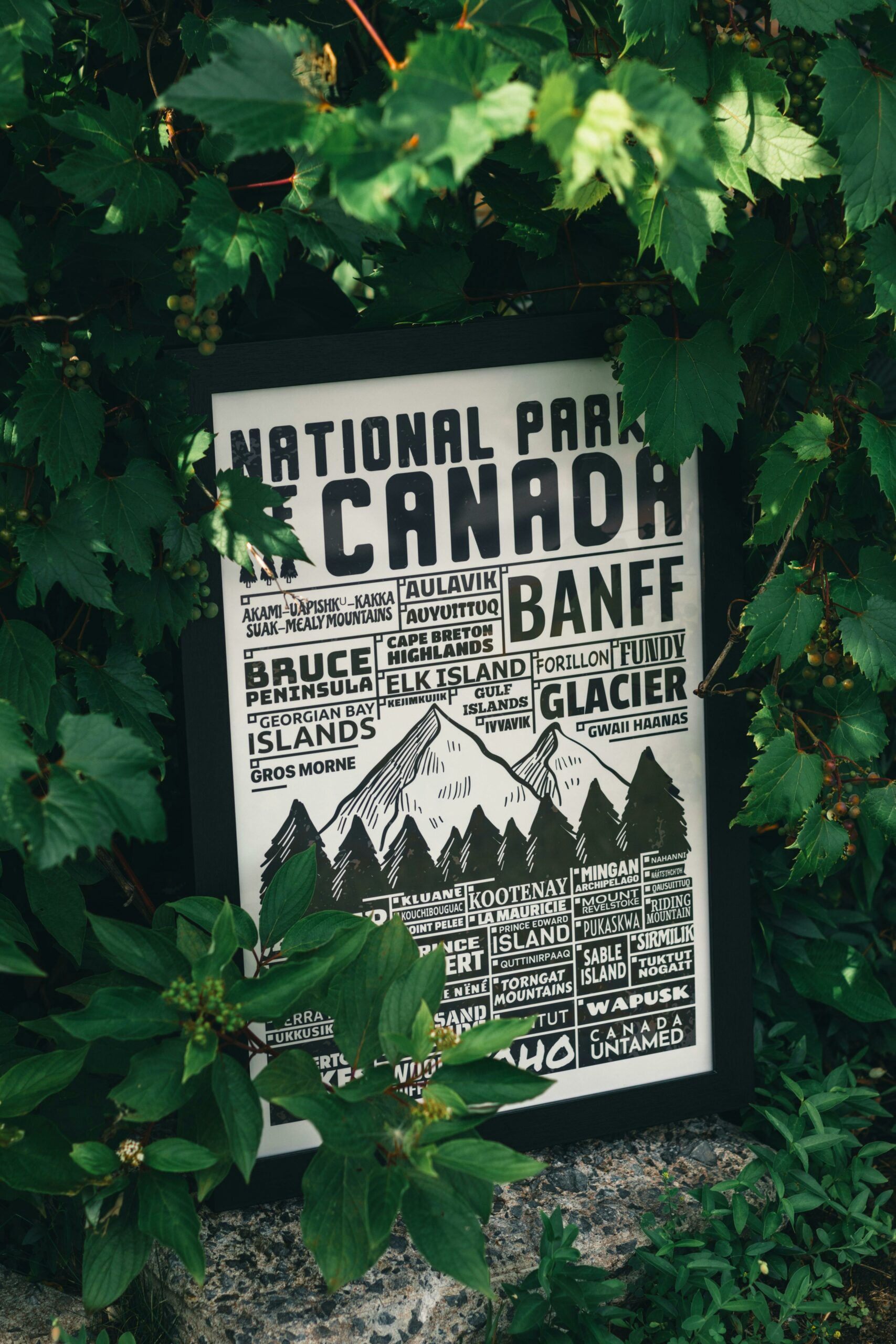
Example
Destination Canada
In 2006, Destination Canada (Canada’s National Tourism Marketing Organization) in partnership with Environics Analytics developed and launched the Explorer Quotient (EQ), a market segmentation system based on psychographic and behavioural factors[7]. EQ emphasizes the importance of traveller segmentation based on their psychological characteristics, such as their attitudes, beliefs, values, motivations, and behaviours. When various psychological characteristics are combined, different types of travellers emerge. These are known as Explorer Types.
Since the launch of EQ in 2006, Destination Canada’s segmentation approach has continued to evolve, reflecting advancements in data analytics and a deeper understanding of traveller behaviour and preferences.
In 2024, Destination Canada launched the Canadian Tourism Data Collective[8], a centralized national platform for sharing and accessing tourism data. This platform hosts a new traveller segmentation program designed to provide a deeper understanding of travelers to and within Canada. This initiative was launched in December 2024 and marks a significant evolution in Destination Canada’s segmentation approach, using advanced data analytics and artificial intelligence (AI) to enhance market insights and competitiveness. Visit https://www.tourismdatacollective.ca/segmentation to learn more about this program.
“The Traveller Segmentation Program by Destination Canada” [2:04 min] by Destination Canada[9]
We will explore the Canadian Tourism Data Collective in Chapter 4
If you are using a printed copy, you can scan the QR code with your digital device to go directly to the video: The Traveller Segmentation Program by Destination Canada

B2B Segmentation Approaches
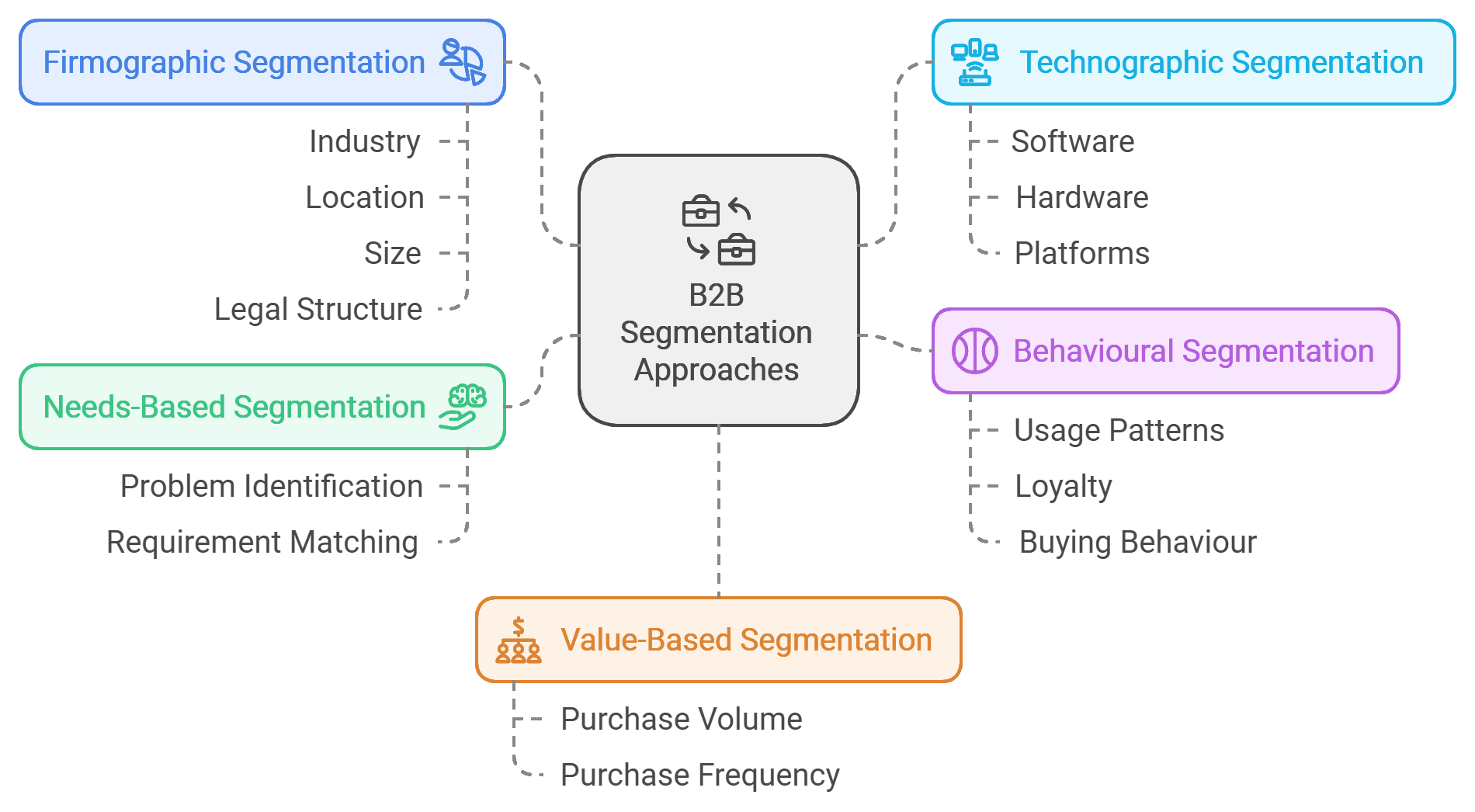
Some of the most common segmentation approaches used in B2B (business to business) markets are:
- Firmographic segmentation
- Technographic segmentation
- Needs-based segmentation
- Value-based segmentation
- Behavioural segmentation
Firmographic Segmentation
Firmographic segmentation involves grouping businesses based on company attributes such as industry, location, size (in terms of revenue or number of employees), and legal structure. Firmographics are comparable to demographics in consumer markets and provide a foundational way to categorize businesses.
Examples
Firmographic Segmentation
Example 1: A hotel chain may target small-to-medium enterprises (SMEs) in urban centres for corporate travel packages, while offering different services to multinational corporations with larger teams.
Example 2: A destination management company might focus on businesses in the technology sector located in Silicon Valley, offering tailored incentive travel programs for their employees.
Example 3: Resorts may segment their offerings by legal structure, such as targeting government organizations with conference facilities or NGOs with discounted group rates.
Technographic Segmentation
Technographic segmentation involves dividing companies based on the technology they use, such as software, hardware, and platforms. It helps in understanding the technological needs and preferences of potential clients.
Examples
Technographic Segmentation
Example 1: A cloud-based property management software company may target boutique hotels using outdated legacy systems, offering solutions to modernize their operations.
Example 2: A restaurant supplier might focus on businesses using specific point-of-sale (POS) systems, ensuring compatibility with their inventory management tools.
Example 3: Travel agencies could market their services to companies using online booking platforms, like Expedia or Amadeus, offering integrated solutions to streamline bookings.
Needs-Based Segmentation
Needs-based segmentation focuses on the specific needs and requirements of businesses. It involves identifying the problems that companies are trying to solve and ensuring that the marketed products or services meet those needs.
Examples
Needs-Based Segmentation
Example 1: A hotel chain might cater to companies needing long-term accommodations for project-based employees by offering extended-stay packages.
Example 2: A tour operator could target event planners looking for unique venues by promoting scenic locations for corporate retreats or team-building activities.
Example 3: Airlines might design packages for businesses seeking cost-effective travel options for frequent flyers, such as bundled tickets or loyalty programs.
Value-Based Segmentation
Value-based segmentation, also known as tiering or profitability segmentation, groups customers based on the potential value they bring to the business. It considers factors like purchase volume and frequency to identify high-value customers.
Examples
Value-Based Segmentation
Example 1: Hotels may prioritize high-value corporate clients who book large-scale conferences regularly, offering them premium discounts and exclusive perks.
Example 2: A catering service might focus on repeat customers like event organizers who consistently generate high revenue through frequent bookings.
Example 3: Travel agencies could create VIP tiers for businesses that book high volumes of travel annually, providing dedicated account managers and customized itineraries.
Behavioural Segmentation
Behavioural segmentation examines how businesses interact with products or services, including usage patterns, loyalty, and buying behaviour.
Examples
Behavioural Segmentation
Example 1: Hotels could segment corporate clients based on booking behaviour — for example, those who prefer last-minute bookings versus those who plan well in advance — and adjust pricing strategies accordingly.
Example 2: Airlines might analyze loyalty program participation to identify frequent business travelers and offer them priority boarding or lounge access.
Example 3: A vacation rental platform like Airbnb could segment clients based on their stage in the customer journey (awareness, consideration, decision) and tailor marketing efforts such as sending destination guides to those in the awareness stage.
Combined B2B Segmentation Approaches
Like consumer market segmentation, organizational markets are often segmented using a combination of approaches. Buyer personas are also used to represent the profile of the ideal customer.
Example
B2B Combined Segmentation Approaches
Buyer Persona: Corporate Travel Manager Carla

Demographics:
- Job Title: Corporate Travel Manager
- Industry: Technology
- Company Size: Mid-sized firm with 500 employees
- Location: Toronto, Canada
Firmographics:
- Annual Travel Budget: $500,000
- Travel Needs: Primarily domestic business travel with occasional international trips for conferences and client meetings.
Technographics:
- Preferred Tools: Uses corporate booking platforms like Concur and prefers hotels integrated with these systems.
- Communication Channels: Email and LinkedIn are primary channels for professional communication.
Needs and Challenges:
- Key Needs: Reliable accommodations close to business districts, flexible booking options, and loyalty programs that benefit both the company and individual travelers.
- Pain Points: Difficulty managing last-minute changes, ensuring cost control, and providing personalized experiences for employees within budget constraints.
Behavioural Insights:
- Booking Habits: Books in bulk for team travel but also handles individual executive bookings. Prefers properties with consistent service standards across multiple locations.
- Loyalty: Likely to remain loyal to brands offering seamless booking processes, corporate discounts, and excellent customer service.
Goals and Motivations:
- Ensure smooth travel experiences for employees while adhering to the company’s travel policy.
- Reduce overall travel costs without compromising quality or employee satisfaction.
Marketing Strategy Example:
A hotel chain targeting “Carla” could offer:
- A dedicated corporate account manager to streamline bookings
- Discounts on group bookings and long-term stays
- Integration with popular corporate travel platforms like Concur
- Flexible cancellation policies to accommodate last-minute changes
This persona provides a clear picture of the target audience’s needs, preferences, and challenges — enabling tourism and hospitality businesses to tailor their offerings effectively.
Media Attributions
- Figure 1: “Beige Wooden Rectangular Chopping Board” by Pixabay (2016), via Pexels, is used under a CC0 1.0 license.
- Figure 2: “B2C market segmentation approaches” [created using Napkin.ai] by author is under a CC BY-NC-SA 4.0 license.
- Figure 3: “Group of Friends Hanging Out” by Helena Lopes (2017), via Pexels, is used under the Pexels license.
- Figure 4: “Family Vacation 001” by Laura H-B (2006), via Flickr, is used under a CC BY-SA 2.0 license.
- Figure 5: “Woman in a Black Blazer Holding a Newspaper Inside the Car” by Pavel Danilyuk (2021), via Pexels, is used under the Pexels license.
- Figure 6: “Women Planting Plants on the Garden” by Centre for Ageing Better (2021), via Pexels, is used under the Pexels license.
- Figure 7: “People Kayaking in Ha Long Bay in Vietnam” by Rachel Claire (2021), via Pexels, is used under the Pexels license.
- Figure 8: “Avatar Clients Icons” by Coffee Bean [coffeebeanworks], via Pixabay, is used under the Pixabay content license.
- Figure 9: “Plog’s model” [created using Microsoft PowerPoint] by the author is under a CC BY-NC-SA 4.0 license.
- Figure 10: “National Park Poster Near Green Leaves” by Ali Kazal (2022), via Pexels, is used under the Pexels license.
- Figure 11: “B2B market segmentation approaches” [created using Napkin.ai] by author is under a CC BY-NC-SA 4.0 license.
- Figure 12: “Woman Wearing Gray Notch Lapel Suit Jacket” by Emmy E (2019), via Pexels, is used under the Pexels license.
- Environics Analytics. (n.d.). PRIZM. Retrieved November 29, 2024, from https://environicsanalytics.com/en-ca/data/segmentation/prizm ↵
- HubSpot Marketing. (2023, April 20). How to create a buyer persona (FREE template) [Video]. YouTube. https://www.youtube.com/watch?v=v6EWN4EjHM0 ↵
- Plog, S. C. (1974). Why destination areas rise and fall in popularity. Cornell Hospitality Quarterly, 14(4), 55–58. https://doi.org/10.1177/001088047401400409 ↵
- Plog, S. (2001). Why destination areas rise and fall in popularity: An update of a Cornell Quarterly classic. Cornell Hotel and Restaurant Administration Quarterly, 42(3), 13–24. https://doi.org/10.1177/0010880401423001 ↵
- Cruz-Milán, O. (2024). A review of empirical research on Plog’s psychographics in tourism. M. A. Camilleri (Ed.) Tourism planning and destination marketing (2nd ed., pp. 1–32). Emerald Publishing Limited. https://doi.org/10.1108/978-1-80455-888-120241001 ↵
- Dr Hayley Stainton. (2021, December 15). Plog's model of allocentricity and psychocentricity made simple [Video]. YouTube. https://youtu.be/EoEVXS8K5w4?si=hV74J_8WseuKZWzM ↵
- Hudson, S., & Ritchie, J. B. (2009). Branding a memorable destination experience. The case of ‘Brand Canada’. International Journal of Tourism Research, 11(2), 217–228. https://doi.org/10.1002/jtr.720 ↵
- Kostuch Media Ltd. (2024, June 13). Destination Canada unveils tourism data collective to boost economic growth. Hotelier Magazine. https://www.hoteliermagazine.com/destination-canada-unveils-tourism-data-collective-to-boost-economic-growth/ ↵
- Destination Canada. (2024, December 2). The traveller segmentation program by Destination Canada [Video]. YouTube. https://youtu.be/7Q6IgNbs0sw?si=GvnPa9JvGSpLgtRu ↵
The process of dividing the market based on demographic factors such as age, gender, income, education, occupation, and family size.
Dividing the market based on location, such as countries, regions, cities, or neighbourhoods. This method is particularly useful for businesses that need to cater to regional preferences or climate conditions.
Segmenting the market based on psychological characteristics, including lifestyle, values, interests, and personality traits.
The division of the market based on consumer behaviours, such as purchasing habits, brand interactions, and product usage rates. This approach helps businesses target consumers based on their actions with the brand.
Detailed, semi-fictional representations of individual customers within market segments. They are created using data and research to embody specific traits, behaviours, needs, and goals of ideal customers.
Consumers who prioritize social and environmental factors in their purchasing decisions. They tend to be more community-oriented and value experiences that benefit others.
Consumers who prefer familiar destinations and experiences. They tend to be risk-averse and seek comfort in known environments.
The segmentation of business markets based on characteristics such as company size, industry, location, and organizational structure.
The process of segmenting consumers based on their technology usage patterns and preferences. This includes factors like device ownership and online behaviour.

